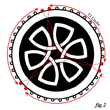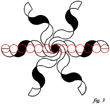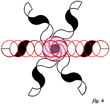A very slow start to the current season has at last given rise to some intriguing, and in some cases stunning, English crop formations, developing intriguing geometrical and symbolic themes begun last year. ALLAN BROWN investigates the thematic links between a few of the most recent designs...
Attempting to analyse some of the geometric themes that have emerged with this year's formations with a ceiling allowance of six diagrams is a rather daunting task, especially as it means I'm going to have throw some geometrical gems overboard in the editing process. But those who have spent time with me will no doubt be greatly relieved at the thought of this self-censoring in action.
The astonishing Milk Hill giant of last year boldly laid down the theme of thirteen, in that each of its arms consisted of thirteen primary circles. As Michael Glickman pointed out at the time, each of the six arms that spiral out from the centre meet the arm next to it at circle seven, two-thirds of the way around its circular trajectory. The centres of these six massive circular arms is on the fourth circle out from the centre. Numerologically, these numbers are evocative of 'matter' (four) and 'spirit' (seven). See fig.1.
The first major Wiltshire formation of the year, first reported on the 2nd June, the lovely Avebury Trusloe 'Celtic Knot', picked up the theme that had been initiated by the Milk Hill 2001 formation. Its six-fold structure is immediately apparent, although its thirteen-fold nature is slightly more hidden. The halo of circles that surround the main design are begging to be counted, and on doing so one discovers there are 39 of them. In fig.2 I have shown how these 39 circles, when split into three groups of thirteen, enclose a primary section of the central knot. It is only now, on having rendered this drawing, that I notice how these imaginary curves, shown highlighted in red, may actually dictate both the sizing and the spacing of the various curvilinear elements that make up the central knot.
I'd just like to spend a moment thinking about how one would go about dividing a circle into 39 parts. 360º divided by 39 gives an angle of 9.23º between any two adjacent circles. This would seem an unworkably precise number to mark out in a darkened field, and even the much more user friendly 9º would yield a 40-fold division as opposed to a 39. If you begin with a precisely marked, pre-measured length, and mark off one of these lengths around the circumference, then from this new point, using the same length, mark off another and so on around the circle, the accumulative error incurred would mean anything from a 38 to a 41-fold division would result. The 39 circles in the Avebury Trusloe formation meander around their true geometrical position, but they are evenly enough spaced apart to be sure that 39 was the number intended.
In yet another lesson of definitive statements immediately unravelling themselves, I've just managed, for the first time, to divide a circle into 39 equal sections using the 'accumulated error' method, although in the process each of the divisions accords precisely with their theoretical placement, whereas the slight meandering of these circles on the ground would mean that this methodology could not have been the one utilised in its construction. Either way, and as always, I thoroughly recommend getting a pair of compasses and having a crack at drawing these formations. Whatever the result of the finished product, you will have deepened your experience of this phenomenon a hundred fold.
The latest Stonehenge formation, which appeared on the 4th July, again picks up on the numerical and geometrical themes explored by these two other formations. Its explicit geometrical structure is again six-fold, and once more the thirteen is the hidden or implicit numerological element. (Once again, Michael Glickman was quick to draw attention to the implicit thirteen, woven into the design.) In this instance, the thirteen emerges as the number of times the small central flattened circle fits into the diameter of the formation. This is clearly highlighted in fig. 3. Each of the three axes of the formation is made up of thirteen small circles, and if the central circle is included in the count of each axis, then we could say the formation is built up around the underlying geometry of 39 identical elements. Notice too, how the formation spans thirteen pairs of tramlines.
It is when we rise above the geometry and the number of these three formations and take a look at their actual topographical positioning in the landscape, that the totality and breathtaking inventiveness of these formations is fully revealed. The 2001 Milk Hill giant lay across the highest field in Wiltshire, with one of its smallest circles out on the far-flung edges of its western arm, almost touching the edge the field, where the wheat gives way to the green grass of the downland as it falls away to the fields below.
The Avebury Trusloe formation, nestled up towards the edge of the field, is flanked by two enigmatic sarsen stones known as 'Adam and Eve', which stand in an adjacent field. Steve Alexander's aerial photograph shows the formation's dramatic siting, with the two solitary stones, Silbury Hill and downlands beyond, all coming together to make up this dramatic composition. It looks to me as if the view from the formation, out between the two stones, runs out directly over Swallow Head Springs and on to West Kennet Longbarrow.
But the award for the most exquisite piece of landscape positioning must go to the new Stonehenge formation, which lies in a field with three of its sine wave ribbon arms brushing up against large tumuli or Longbarrows that effectively frame the design. I mean, come on! This is craftsmanship we're seeing here, this is a supreme lesson in spatial awareness and topographical sensitivity. I am informed that the lay in this formation was exquisite, and flowed outwards from the central circle.
Another theme that has been explored both explicitly and implicitly has been that of duality. For the Sacred Geometer, duality is not only a subject of metaphysical contemplation, but has a direct and tangible geometrical expression. Traditionally, duality would be expressed geometrically through the figure of the Vesica Pisces. This traditional model is highlighted in fig. 4(a) and as well as showing the basic figure of the Vesica Pisces, it contains two additional circles. The small centrally contained circle and the large outer containing circle. Another method for describing the movement from unity into multiplicity, is demonstrated in the same diagram 4(b). It is this alternative methodology of describing duality that seems to be making itself felt in the design and structure of several formations.
The Avebury Trusloe formation, orientated as it is along the aforementioned alignment, alludes to the archetypal duality of the male and the female, with the alignment running directly between the two Adam and Eve 'longstones'. The beautiful West Overton entwined spiral 'serpents' make a more emphatic statement about duality. The directional polarities of the serpents emerge from the central unity of the cosmic egg, whilst the design naturally engenders a sense of the infinite expanse of the surrounding field and the space beyond, being drawn slowly towards the centre of the labyrinth, where they find a dualistic, finite resolution as the tips of serpent's tails. Implicit in the underlying construction of the formation is the alternative geometric methodology for describing duality. This can be clearly seen in fig. 5. The diagram also highlights the fact that the small central circle, from which the geometry of the formation unfolds, is of exactly the same size as the serpents' heads.
With my last and final diagram I would like to return to the Stonehenge formation and draw your attention to the same dualistic methodology that underlies the geometry of the West Overton serpents. In fig. 6 we can see that if the small central circle of unity that lies at the centre of the formation is expanded out into duality, then the two primary 'dualistic' circles that emerge from this construction, when extrapolated out in a series of traditional Vesica Pisces, make up the bones of the formation. Thus the geometry of this formation can also be described as an expanded model of duality, flowing out along the axes of three-dimensional space.
As my diagrams are now all used up, I am left merely with words to describe the two Sussex formations that have been a great source of nourishment and teaching to me [photos and details of all of the formations referred to here can be found in the 2002 pages of the website www.cropcircleconnector.com - see the link at the foot of the main Headlines page]. With the recent arrival of my third child, I have stayed close to home this summer and, as such, have spent more time in these two formations then I have done in any others before. The first formation was a 'dualistic spinner' and, despite an initial surveying error, has revealed a most astonishing geometry. I would urge anyone interested in finding out more about the geometry of this formation, to visit Martin Keitel's website 'FCCI suomeski' for his analysis of this formation. See:
http://www.ioon.net/cropcircles
The second Sussex formation played around with the 'convex equilateral triangle', a theme that manifested dramatically, with a series of formations, at the start of last year's season. Although a simple formation in geometric terms, the complexity of the lay still has me completely baffled and I'm left with the distinct sense of the various arcs and circular components that make up the formation being laid down almost simultaneously. The crop has a large amount of grass growing within it and the tramlines are quite deep and rutted. Nevertheless, the crop flows and swirls and in numerous places is pulled off its trajectory by the counterflow of an underlying element. I hope to write more on the lay of this formation on another occasion, but would just like to point out that whatever the origin of the white powder found liberally scattered around the centre of the formation, it is unfortunately neither sherbet dip or cocaine, and despite Andy Thomas's claim only to have experimented with the former, his initial gum rubbing test on the stuff indicates that his years of being a gigging musician have not been entirely without merit! (Please, I jest!)

Fig.1 |

Fig.2 |

Fig.3 |

Fig.4 |

Fig.5 |

Fig.6 |